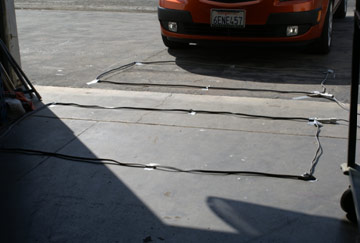Tests & Results
Phasing Test
Purpose:
– Observe and record what happens when two loops are hooked in series to identify any benefits or problems.
– Obtain the closest “Stand Off” distance two loops can be when properly phased.
Hypothesis:
If two loops hooked in series are properly phased, then the detection fields will repel each other.
If two loops hooked in series are not properly phased, then the detection fields will attract each other.
Materials:
Procedure:
Testing area was prepared by sweeping the surface so the duct tape will easily stick to hold loops in place. Loops were positioned in 3×9 dimensions, 2ft away on each side of the overhead door. Duct tape was used to hold loops into position. The lead-in of each loop was then hooked in series, out of phase to the EDI detector. After making sure the overhead door was in its complete open position, the detector was set to a sensitivity level of 5 and reset. The door was then sent to close and a detection occurred, and deflector meter data recorded. The loops were then properly phased, the door raised, the detector reset (at a sensitivity level of 5), and the door sent to close. No detection was recorded. The above process was repeated while the loops were properly phased at sensitivity levels of 7 and 9 and their data/results recorded.
While the loops were still properly phased they were pushed inward towards the overhead door to see how close two loops could be before a detector occurs. Each time the loops were positioned 1inch closer on each side at the maximum sensitivity setting (9), resetting the detector, opening and closing overhead door until a detection was recorded. The distance on each side of the door was then recorded.

Showing how the loops were positioned
Results:
Loops not properly phased:

Loops properly phased:

Results show that when BD Loops are hooked in series and properly phased they can be as close as 19 inches away on the highest sensitivity setting with no detection occurring.
Conclusion:
When two loops hooked in series are properly phased, then the detection fields will repel each other.*
When two loops hooked in series are not properly phased, then the detection fields will attract each other.*
Closest “Stand Off” distance can be 19 inches away, but this is not what BD Loops recommends for a standard installation.
BD Loops recommends a “Stand Off” distance of 2ft (24 inches).*
*Loops Phasing effects only apply to two loops hooked in series to a slide/vertical gate or overhead door.
BD Loops – What these Results Mean for Installers
BD Loops recommends the “Stand Off” distance to be 2ft when loops are hooked in series, properly phased on a slide/vertical gate (or overhead door) system because there may be extenuating circumstances that may cause the gate or door to move that can result in a detection. By understanding loop phasing loops can be installed 2ft away instead of the usual 4ft away. This will then only allow 4ft total to be in-between each loop which eliminates the chance of a small vehicle coming in contact with a door or gate resulting in a safer system.
BD Loops
The Loop Experts!
BD Loops was founded in 2001. Their preformed loops and accessories are designed with the installer in mind. BD Loops offers a complete loop system solution including preformed direct burial loops, preformed saw-cut loops, loop sealant, blades, testing devices, and installation tools. BD Loops has a reputation for reliability and ease of installation. They pride themselves on the quality of their products and their commitment to providing excellent customer service and support. BD Loops preformed loops are made in the USA at their facility in Placentia, CA.

